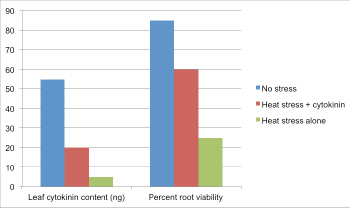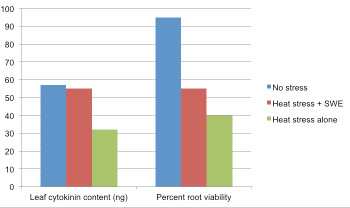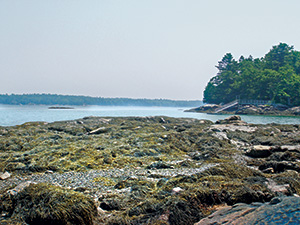Cytokinins and seaweed extracts for summer putting green health
By Erik H. Ervin, Ph.D.
Summer decline of creeping bentgrass and Poa annua putting greens is becoming so prevalent in the upper South and transition zone that many courses have converted to ultra-dwarf bermudagrass. However, for those keeping their cool-season greens, the issue of summer decline remains, indicating that we must understand it and implement best practices for prevention.
Summer decline begins when upper root zone temperatures reach above 85 degrees F consistently. Sustained high temperatures, coupled with low mowing heights, mechanical stresses and disease pressure begin to overcome the plant’s physiological defenses, and decline begins.
The speed of decline is influenced by a number of factors, some more manageable than others. Bruce Martin, Ph.D., of Clemson University contends that “fans are the best new fungicide that have come on the market in years.” And he’s right. You can prevent summer decline by improving the physical environment. And you can do that by increasing air movement and decreasing the extent and duration of high root zone temperatures, whether through fans, tree removal, precision irrigation or venting.
The next pieces of the prevention puzzle include spray inputs, such as fungicides, fertilizers, colorants, PGRs, wetting agents and cytokinin-based biostimulants.
Why cytokinin-based biostimulants?

Figure 1: High natural leaf cytokinin content under no stress correlates closely with high root viability. Under 95°F heat stress, root zone injection of a synthetic cytokinin translates into greater subsequent leaf cytokinin content and root viability when compared to not applying cytokinin. Data adapted from Liu and Huang. 2002. Crop Science. 42:457.
Cytokinins are a type of phyto-hormone that direct a number of growth and stress-response processes. For growth, they signal cells to divide at the crown, so new roots, shoots and stems begin to develop. For stress response, they act to inhibit the action of senescence-inducing enzymes, slowing the degradation of chlorophyll and maintaining photosynthetic rates and root viability. In short, cytokinins are known as the “stay green” hormone. Cytokinin levels must remain elevated in leaf tissues to slow the summer decline process. They’re produced in healthy root tips and translocated to shoots via the transpiration stream. Consequently, as summer root decline proceeds, leaf tissue cytokinin levels drop.
Knowing the potential stress-protective effects of cytokinins from the plant physiology literature, in the early 2000s Bingru Huang, Ph.D., of Rutgers University investigated whether root injection of synthetic cytokinin would alleviate heat stress decline of creeping bentgrass (Figure 1).
The results were quite positive, showing that greater maintenance of chlorophyll and photosynthesis was related to increased leaf tissue cytokinin content. This, in turn, resulted in 35 percent less root loss.
Concurrent with Dr. Huang’s research on root-injected cytokinins, my research group developed the hypothesis that the relatively high background levels of natural cytokinins in seaweed extracts (SWE) would most likely also boost creeping bentgrass tissue cytokinin levels and have similar positive stress-protective effects.

Figure 2: High natural leaf cytokinin content under no stress correlates closely with high root viability. Under 95°F heat stress, foliar application of a SWE translates into greater subsequent leaf cytokinin content and root viability when compared to not applying cytokinin. Data adapted from Zhang and Ervin. 2008.
Crop Science. 48:364.
My published results with SWE-based cytokinins are in Figure 2. These data show that repeated (14-day) foliar applications of SWE over 42 days of heat stress resulted in leaf cytokinin contents that were just below that of non-heat stressed creeping bentgrass and 42 percent higher than heat-stressed creeping bentgrass that had not received SWE applications.
Boosted leaf tissue cytokinins due to SWE foliar application translated into 15 percent less root decline over the 42-day heat stress trial.
These SWE positive results have been repeatable. My group has published research showing similar effects for cool-season turfgrasses subjected to drought, salinity and UV-light stress. Dr. Huang’s subsequent research has shown that creeping bentgrass can be genetically modified to “turn on” more cytokinin production in the early stages of stress detection, resulting in transformed lines that retained 50 percent or more root mass under drought stress than the comparable commercial cultivar. For the immediate future, superintendents will not have access to “cytokinin-overproducing” genetically modified varieties, so let’s turn our attention back to the more natural approach of supplementing with SWE.
Does source and processing matter?
 Where do the SWEs used most commonly in commercial biostimulant formulations come from and how are they processed? They most commonly come from Ascophyllum nodosum or north Atlantic rockweed, harvested off the coasts of Maine, Nova Scotia, the United Kingdom and Scandinavia (see photo, right). The information on processing below was provided by Ocean Organics Corporation of Maine.
Where do the SWEs used most commonly in commercial biostimulant formulations come from and how are they processed? They most commonly come from Ascophyllum nodosum or north Atlantic rockweed, harvested off the coasts of Maine, Nova Scotia, the United Kingdom and Scandinavia (see photo, right). The information on processing below was provided by Ocean Organics Corporation of Maine.
Different intended uses require different processing. Moving from least refined to most specialized, we start with dehydrated whole plants. Called “seaweed” or “kelp” meal, they are used as soil amendments. The terms seaweeds, seaplants and kelp plants are used interchangeably.
These products are sometimes dried in the sun, in oil (or wood-fired) commercial dryers or in both. The proposed benefits to incorporating kelp meal into the soil are to increase the cation exchange capacity, add micronutrients, provide natural complexed sugars that may promote microbial health and increase water-holding capacity. The whole plants contain plant hormones and other plant active compounds, but the fate of those molecules is unclear due to the variables associated with the product’s decomposition in the soil.
The next step along the processing continuum would be the liquefaction of the plants. Liquefied kelp are basically whole seaplants reduced mechanically to small enough particles so that they can be sprayed — basically applying the whole seaplant as a liquid. This is effectively a liquid version of dried seaweed. Proportionally, there is much more organic matter in this type product, but it degrades faster in the soil. It’s likely that some of the water-soluble hormones and other plant active compounds remain intact for foliar or soil uptake.
Cold process extracts. There are several companies using this approach. It is the breaking down of the plant cells through mechanical (not chemical) means, but it doesn’t include the whole plant in the way liquefied products usually do. I haven’t worked with any companies that use cold processing to produce SWE.
The next step would be chemical extraction or leaching of the plant active compounds. These are the classic extracts that have been the focus of the research results I am presenting in this article.
Alkaline extracts. Kelp is chemically digested at high pH. This method most likely began when farmers added wood ashes to seaweed to make a tea. This is the largest category with respect to the number of variations on the concept, and probably the gallons produced.
Alkaline SWEs are the compounds used exclusively so far in my research trials. They’re the filtered mixtures of suspensions of the soluble and insoluble parts of the kelp. Heat is typically part of the process, and the temperatures used vary with the processor. Some processors use temperatures well above the boiling point of water. The end product of an alkaline extraction is often dehydrated to a black powder or flaked product to be remixed with water.
Processors planning to produce a powder aim to chemically and mechanically digest the kelp to maximize the yield of the soluble and suspendable solids. Settling out of the suspended solids in these products is sometimes a problem.
Does rate matter?
It’s a valid question since we are dealing with hormones-compounds that cause plant growth changes at very low concentrations (nanograms or 10-9) in plant tissues. If these compounds are over-applied will we see abnormal or injurious growth responses? Or, since it only takes nano-changes in concentrations to have positive growth effects, can standard spray rates be reduced? The cytokinin levels in the undiluted SWEs that we tested have ranged from 5 to 125 parts per million (ppm or 10-6). At normal dilution rates, we have compared two SWE sources applied at 3.5 ppm each or what amounted to about 3 to 4 oz. SWE per 1000 ft2. Under heat stress we compared this 1x rate (3 oz.) to 0.1x and 10x rates for effects on creeping bentgrass.
Our results showed that rate mattered in terms of applying enough. The 0.1x rate did not supply enough cytokinins to match the improvements seen with turf quality, chlorophyll levels and nitrate uptake provided by the 1x rate. However, these positive heat stress tolerance effects were matched by the 10x rate, with no negative consequences. The 10x rate did not provide any measures of improved stress tolerance over the 1x rate, so save your money and stick with the label.
Does placement matter?
I don’t think so. Standard practice in our trials is to foliar apply then lightly overhead irrigate the next day. In one study, however, we foliar applied and sub-irrigated. Both methods demonstrated similar results in the trials. As far as root absorption is concerned, Huang’s research showed positive results when the cytokinin was syringe-injected to the root zone. So go ahead and stick with the standard practice of foliar application, with the only worry of activity loss being if application is followed by a large rainfall or irrigation event.
Does timing matter?
Our research indicates that cytokinin levels are optimized under optimal temperature and moisture conditions (such as conditions that can occur in the spring and fall) and cannot be boosted to an extent that makes a plant health difference. However, as temperatures increase in late spring, and the chances for stretches of 7 to 14 days of unseasonable heating or drying increase, our recommendation is to begin applications.
Our research has shown that a 30-day interval between applications can suffice at first, but as heat and plant metabolism rates increase, we recommend shortening the interval to 14 days. The shorter interval in the hottest summer weather is due to the fact that cytokinins and other ingredients in SWEs are organic and break down faster in the environment and in the plant as temperatures increase.
Does mixing with a PGR matter?
There are small amounts of other hormones, such as auxin and gibberellic acid (GA), in SWEs. So will a tank mix of SWE with an anti-GA PGR cancel each other out? We have looked at this question over a summer season on a putting green in Virginia with an alkaline SWE, mixed or not with Primo.
There were never any clipping yield differences between Primo by itself or mixed with the SWE. However, in comparison to a fertilizer control or Primo + fertilizer, the Primo + SWE plots consistently displayed the highest summer quality.
Are there other biostimulant products on the market that contain higher levels of GA that could be a cause for concern in terms of negating PGR effects? Yes. Always pay attention to labels and question product reps closely about such issues before tank-mixing.
Summer stress will most likely continue to be relentless in the coming years. SWE-based biostimulants can help, but they must be part of a larger cultural management program that revolves around creating and maintaining a physical environment that promotes air movement and temperature moderation.
Erik Ervin is a professor of turfgrass culture and physiology at Virginia Tech. He can be contacted at eervin@vt.edu.








